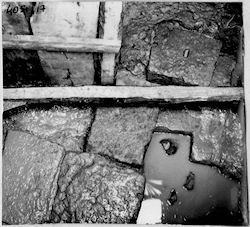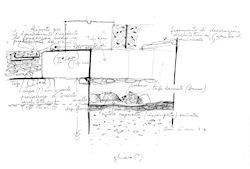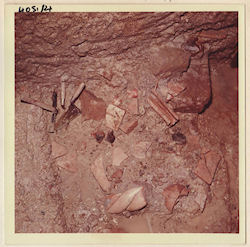
Figure 43: Settore II. Excavation in progress (AFSRCM, S. Omobono, b. 32, 6, c. 3902)
Settore II, corresponding to the back room of the taberna in which settore I is located (Figure 34), was excavated in two phases between August 1962 and August 1963. The excavation area, extending over a surface of approximately 2.70 by 2.20m, took the form of two soundings of equal dimensions (C on the west and D on the east).
The first campaign of excavation, carried out by Ioppolo under the direction of Colini, began with the opening of sounding C in August of 1962 (Figure 43); this campaign is not at all well documented, as the excavation diary begins on 29 August, 1963, with a reference to the 'riapertura del pozzo C' (reopening of well C) (AFSRCM, S. Omobono, b. 31, 1, c. 4051.1). Although there are no records of the stratigraphy excavated in 1962 within this sounding, it was recorded that approximately 5.50m from the Republican pavement was a surface of tufo blocks, interpreted by the excavators as the base of the Archaic area (Figure 33; it should be noted that sounding C measured only 1.8 by 1.2m; for the identification of the surface of tufo blocks as the base of the Archaic structures, see AFSRCM, S. Omobono, b. 27, 1, c. 2676o; cf. Ioppolo 1972, tab. 1; Colonna 1991, 52).
In August 1963, work resumed in sounding C with the excavation of a further 2m of stratigraphy over an area of 0.9m² below the level of the altar. This sounding revealed a surface of tufo fragments with traces of charcoal, covered by a 'strato argilloso sterile con sotto mezza ciotola ad impasto' (sterile clayey layer with half of an impasto bowl underneath) (Figs 44 and 45). This feature was interpreted as a sacrificial pit connected to cult activity before the beginning of monumental construction in the area at the onset of the 6th century BCE. It should be noted that Ioppolo mistakenly places this feature under layer D12 in settore II rather than in sounding C (1972, 12-13, fig. 6). It is possible that this erroneous attribution stems from a misreading of the stratigraphy as it was published; Ioppolo only considers section D for settore II and E for settore IV, reconstructing from these and unifying the layers and structures uncovered in all five soundings (A, B, and E for settore IV and C and D for settore II). Moreover, the excavators themselves often seem to confuse the designations of the two settori and the layers within them (AFSRCM, S. Omobono, b. 31, 1, c. 4051.2, 5-7, 25).


Figure 44: Remains of the Archaic altar, the impasto cup (centre), and architectural terracottas (centre, top, and between the stone block and the wooden planks) in settore II (AFSRCM, S. Omobono, b. 31, 1, c. 4051.10)
Figure 45: Work in sounding C of settore II. Sketch by Ioppolo dated 13/09/1963 (AFSRCM, S. Omobono, b. 31, 1, c. 4051.9)
The following day, a deposit of architectural terracottas pertaining to fragments of simas in the shape of feline heads, polychrome elements with a motif of curving bands, and a first-phase frieze with winged horses was brought to light nearby (AFSRCM, S. Omobono, b. 31, 1, c. 4051.9; for the analysis of the fragments, see Mura Sommella 1977a; 1977b).
The excavation of sounding C continued down to a depth of approximately 8m below the Republican pavement, unearthing only thin layers of sand and gravel, mostly poor in materials (Ioppolo 1972, 11-12; cf. AFSRCM, S. Omobono, b. 31, 1, c. 4051.9). For this reason the excavators decided to close the sounding.
A few days later, on 25 September, the excavation of sounding D (approximately 2.20 by 1.40m) was begun in order to complete the investigation of settore II. The excavation diary records that the spoil from individual layers was placed within separate heaps separated by wooden planks and sieved only subsequently (AFSRCM, S. Omobono, b. 31, 1, c. 4051.5, 15).
For layers 1-6 of sounding D, only a summary description based on the eastern section documented after the excavation of sounding C is available (Figure 46). The superficial layer D1, with variable outline and thickness, was characterised by a reddish-brown colour resulting from the presence of crumbled tufo and a few traces of charcoal. This layer covered a beaten-earth surface (D2) along the brick wall of the taberna, which itself covered a clayey layer (D3), approximately 10cm in thickness containing numerous brick fragments from the construction of the wall of the taberna. D4, underneath D3, was a fill characterised by an organic matrix with very small fragments of charcoal; it covered another fill (D5), between 50 and 100cm in thickness and also characterised by an organic matrix with small- to mid-sized pebbles, clay clumps and, in the lower part, numerous tufo fragments. This layer was removed on 26 September 1963, while the following day saw the excavation of D6, a 'a forma di cuneo' (wedge-shaped) layer with large fragments of tufo and numerous concentrations of yellowish-brown clay. Below was D7, a light brown, clayey layer of variable thickness (AFSRCM, S. Omobono, b. 31, 1, c. 4051.8).
The 3rd of October saw the excavation of D8, a layer of variable thickness (up to 70cm) characterised by a clayey matrix and numerous fragments of tufo rosso; at the same time, the spoil from previously excavated layers began to be washed and sieved. D9, a 'strato di riporto leggermente organico' (lightly organic fill layer) with little material, was excavated the following day (AFSRCM, S. Omobono, b. 31, 1, c. 4051.8, 20).
The 8th and 9th of October saw the excavation of D10, a rather thick (65-90cm) clayey layer containing various fragments of impasto and a little bucchero and imported pottery, together with many fragments of architectural terracottas, most of which were found in the lower part of the layer, almost on the surface of the base of cappellaccio blocks below (Figure 47; AFSRCM, S. Omobono, b. 31, 1, c. 4051.19; AFSRCM, S. Omobono, b. 27, 1, c. 2676m). After securing the trench in order to prevent the frequent collapse of the walls, the excavators planned to undercut under altar B (AFSRCM, S. Omobono, b. 31, 1, c. 4051.20; AFSRCM, S. Omobono, b. 29, 10, c. 3605.1); this project was abandoned because of a problem encountered in a preliminary sounding, thereby bringing the investigation of the trench to a close on 17 October (AFSRCM, S. Omobono, b. 31, 1, c. 4051.22).

Figure 47: Fragments of architectural terracottas in settore II (AFSRCM, S. Omobono, b. 31, 1, c. 4051.21)
The analysis and interpretation of the stratigraphy from this trench are included with settore IV, as the two were excavated in the same years and published together by Ioppolo (1972).
© Internet Archaeology/Author(s)
University of York legal statements | Terms and Conditions
| File last updated: Mon Mar 12 2012